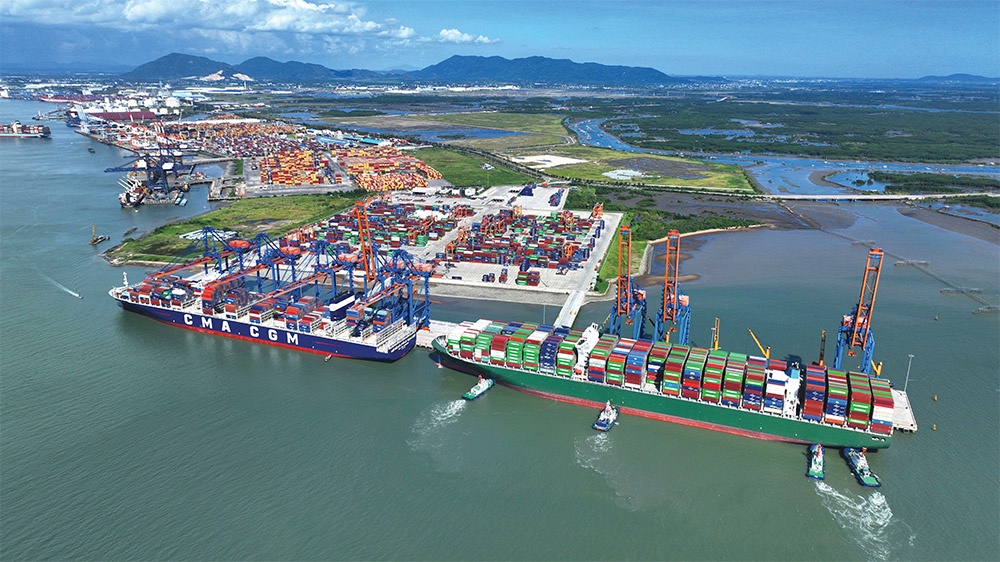Vietnam’s healthy trading market potential highlighted
Improving access to trade finance could increase imports and exports by up to 6-9 per cent respectively in Vietnam, equivalent to an annual increase in merchandise trade of $55 billion, according to a report by the World Trade Organization (WTO) International Finance Corporation (IFC).
Speaking at the report’s dissemination event in Hanoi at the end of February, Marc Auboin, a WTO counsellor of Economic Research and Statistics, said Vietnam’s trade finance market is the most sophisticated and advanced in the Mekong region. However, while the market is $150 billion in size, domestic banks are supporting only 21 per cent of the country’s total merchandise trade.
“In a sense, the effort Vietnam is already making towards the mobilisation of assets is already substantial, but the trading sector has certainly a potential to grow even more,” he said.
According to the report, local trade finance in Vietnam is scarce, costly and segmented, offering only traditional services. Importers and exporters cited high collateral requirements and onerous application processes among the main reasons why they did not seek support from local banks.
On the supply side, Vietnamese banks rejected an average of 12 per cent of trade finance requests – mainly from small- and medium-sized enterprises (SMEs) – accounting for around $20.3 billion in unmet demand in 2022. Rejections are attributed to a lack of collateral and high credit risk.
Auboin emphasises that while the common perception is that trade finance merely facilitates trade, recent studies suggest a reversed supply-demand relationship: increased trade finance correlates with increased trade activity.
“SMEs would use their family finance or their working capital, and it would seem simpler than actually going to a bank. It’s not really that they don’t need trade finances. They may not know that there is a more efficient and perhaps a cheaper way to manage their working capital and optimise their cash flows, other than a question of need,” he noted.
 |
| Vietnam’s healthy trading market potential highlighted, photo Le Toan |
Raft of limitations
The report highlighted that increasing coverage is more important than reducing trade finance costs. In turn, it suggests developing supply chain finance and digital solutions to cut costs and enhance access, necessitating robust regulatory frameworks covering collateral, digital transactions, central bank policies, and more.
Nguyen Quoc Hung, secretary-general of the Vietnam Banking Association, said that the banking industry is committed to providing financing for enterprises of all sizes. However, he acknowledged that large businesses often find it easier to access bank capital due to their robust financial capabilities, ability to meet requirements, and extensive business networks, ensuring stability.
“On the other hand, SMEs face challenges such as financial instability, lack of transparency in financial reporting, and limited capacity to fulfil conditions set by banks,” he assessed, urging that businesses enhance their capacity to meet bank requirements, thereby fostering trust in lending activities.
Additionally, Hung anticipated that the enactment of the new Law on Credit Institutions by the National Assembly, coupled with the timely issuance of decrees and circulars by the State Bank of Vietnam to guide this law, will facilitate the robust development of trade finance activities.
Tran Long, BIDV’s deputy CEO, identified several main reasons for the limitations in SME trade financing, including a lack of transparency in financial statements, as well as limited experience in corporate governance and communication hindering their ability to access and utilise products offered by credit institutions.
“Additionally, there are regulatory constraints which treat trade finance tools similarly to loans, requiring SMEs to obtain credit limits from banks to access trade finance products,” Long explained.
As pointed out in the report, the majority of trade finance activities are currently relying on conventional instruments. IFC senior economist Tran Thu Trang noted the potential for advancement in the sector, suggesting that banks prioritise the development of innovative tools.
“Leveraging supply chain finance can particularly benefit SMEs, a segment currently facing challenges and experiencing limited access to trade finance compared to larger enterprises,” she assessed.
To foster the adoption of these modern financing instruments, she advises two key strategies: enhancing the legal framework to address collateral requirements, digital transactions, and regulatory standards set by central banks; while raising awareness for SMEs and local suppliers to facilitate their understanding and utilisation of trade finance mechanisms.
Vital role of tech
From a banking perspective, Dinh Ngoc Dung, head of Corporate Banking at SHB, said the multifaceted benefits of trade finance, particularly in supply chain operations. Beyond financing enterprises and facilitating payment methods, the bank provides invaluable advisory services on market access and partner evaluation to mitigate risks for all stakeholders.
Moreover, scaling up this endeavour necessitates substantial investments in digitalisation and technology, with extended capital recovery periods in supply chain financing.
“Nonetheless, SHB representatives remain optimistic about the robust development of supply chain financing in Vietnam, buoyed by the collective efforts of IFC, businesses, and other stakeholders,” he said.
Iin September 2023, SHB signed an agreement with IFC to join the Global Trade Finance Programme (GTFP).
Under this agreement, SHB acts as the issuing bank with an initial trade finance guarantee limit of up to $75 million granted by IFC. Participation in the GTFP enables SHB to foster trade growth and expand its global partner banking network and support import-export activities of domestic businesses.
Long of BIDV emphasised the pivotal role of technology advancement in leveraging modern tools like supply chain finance. “Tech innovations facilitate seamless connections between banks, buyers, sellers, distributors, and logistics firms across the supply chain,” he stated, sharing that BIDV has collaborated with the Asian Development Bank over the past 2-3 years to develop a comprehensive supply chain finance platform. The initiative has propelled BIDV’s progress by 200 per cent annually, spanning sectors including real estate, retail, and agriculture.
In December, Standard Chartered Bank signed an agreement with BIDV for a sustainable trade loan of up to $100 million to support BIDV and its clients in achieving sustainability goals. Under the deal, Standard Chartered Bank in Vietnam will arrange trade loan financing for BIDV’s sustainable transactions, facilitating businesses and projects’ access to green finance and supporting Vietnam’s green transformation.
 | Vietnam targets key sectors to cement status as prime investment destination To bolster its position as a hub for investment, Vietnam continues focusing on three key areas land infrastructure, human resources, and institutional reform, according to Deputy Minister of Planning and Investment Tran Quoc Phuong. |
 | New review nears on Vietnam’s unregulated fishing status The Vietnamese government is intensifying a crackdown on unregulated fishing, in a bid to abide with regulations set in the EU-Vietnam Free Trade Agreement and the Food and Agriculture Organization. |
What the stars mean:
★ Poor ★ ★ Promising ★★★ Good ★★★★ Very good ★★★★★ Exceptional
 Tag:
Tag:
Related Contents
Latest News
More News
- Businesses ramp up production as year-end orders surge (December 30, 2025 | 10:05)
- Vietjet chairwoman awarded Labour Hero title (December 29, 2025 | 13:06)
- How to unlock ESG value through green innovation (December 29, 2025 | 10:03)
- AI reshapes media and advertising industry (December 29, 2025 | 08:33)
- FPT and GELEX sign deal to develop blockchain tech for global markets (December 29, 2025 | 08:29)
- Vietnam’s GDP forecast to grow by 9 per cent in 2026 (December 29, 2025 | 08:29)
- Women entrepreneurs are key to Vietnam’s economic growth (December 29, 2025 | 08:00)
- Vietnam's top 500 value-creating enterprises announced (December 27, 2025 | 08:00)
- The PAN Group shaping a better future with ESG strategy (December 26, 2025 | 09:00)
- Masan Consumer officially lists on HSX, marking the next phase of value creation (December 25, 2025 | 13:20)




















 Mobile Version
Mobile Version